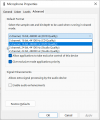Hello, as a retirement hobby, I wrote a free and open source spectrum viewer application. I use Windows 7 for development, but finally bought a Windows 11 notebook that I can test on. With Windows 7, I can hold a digital watch to the microphone and see the 32,767 Hz peak from the quartz crystal oscillator of the watch. That makes a pretty good demo and I was thinking of including the demo in a youtube video, if I end up making one.
My Windows 7 desktop and notebook both support the needed 96000 Hz sample rate. The desktop even supports 192000. I find ordinary cheap microphones can pick up a signal up to about 80 KHz. My headphones can play in this range too. There are all kinds of interesting experiments and uses for these high sample rates, even those humans can't hear in this range.
My new HP Elitebook 845 G9 arrived yesterday, and I was really surprised to see its Windows 11 OS can't even match the sampling rates of my ancient Windows 7 machines. Apparently Windows 10/11 artificially limit the sampling rate of ordinary motherboard audio. So now I am trying to force Windows 11 to use older drivers as a workaround to this apparent Microsoft bug/feature. All my machines have Realtek audio, and they have supported 192000 Hz sampling rate for ages. Does anyone know what is going on with this?
My Windows 7 desktop and notebook both support the needed 96000 Hz sample rate. The desktop even supports 192000. I find ordinary cheap microphones can pick up a signal up to about 80 KHz. My headphones can play in this range too. There are all kinds of interesting experiments and uses for these high sample rates, even those humans can't hear in this range.
My new HP Elitebook 845 G9 arrived yesterday, and I was really surprised to see its Windows 11 OS can't even match the sampling rates of my ancient Windows 7 machines. Apparently Windows 10/11 artificially limit the sampling rate of ordinary motherboard audio. So now I am trying to force Windows 11 to use older drivers as a workaround to this apparent Microsoft bug/feature. All my machines have Realtek audio, and they have supported 192000 Hz sampling rate for ages. Does anyone know what is going on with this?



